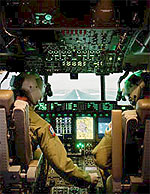C-130J accident report: Propping up yoke to unload cargo not uncommon, expert says
 An Air Force Mobility Command accident report released April 15 pinpointed the cause of a C-130J crash in Afghanistan last year: a forgotten night-vision googles case jammed behind the control yoke used to steer the plane.
An Air Force Mobility Command accident report released April 15 pinpointed the cause of a C-130J crash in Afghanistan last year: a forgotten night-vision googles case jammed behind the control yoke used to steer the plane.
The pilot had used the case so he didn't have to manually hold the yoke in place to keep the elevators as high as possible for unloading and loading cargo.
It was a tragic mistake, but the practice itself is long-standing.
Retired Chief Master Sgt. Kelly Jones, who has more than 7,000 flight hours aboard a C-130, said that while it's not common, pilots occasionally do need to raise the elevators on the tail of the plane to load especially tall items. They do that by means of the yoke.
"The elevator on the 130, just sitting static, droops down quite a bit," Jones told Air Force Times. "And to load that really high cargo, you’ve got to pull back on the yoke, raise the elevator, and get the cargo on. There’s no official way to do that other than holding it up by hand."
Jones, who served as a flight engineer on C-130s from 1965 to 1995, said crews would sometimes use a wheel block — used to prevent aircraft from rolling while parked — to prop up yokes while loading or unloading cargo.
"It wasn’t sanctioned, it was just something you did," he said. "Not always, just sometimes. It’s the end of a long day and you’re tired. Someone wants to stand up and walk around, you’d use something artificial to hold that up."
"We didn’t have the hard night-vision goggle cases back then. If we had had those, I suppose we would have done the same thing," continued Jones, who is now the president of the Abilene, Texas, chapter of the Air Force Association.
The crew was offloading cargo while keeping the aircraft engines running, aiming to speed operations and takeoff time, Jones noted. In that scenario, the pilot and co-pilot may not have performed the full pre-flight check that includes ensuring no flight controls are blocked and that flaps and ailerons have a full range of motion.
And with only the pilot and co-pilot in the cockpit, both wearing nigh-vision goggles, Jones said he's not surprised the NVG case was missed.
"Had there been a third of fourth set of eyes in the cockpit, I can’t help but feel that that would have been caught. No way to tell that for certain, though," he said. "I hate to criticize anybody. It’s so sad and so unfortunate that this happened. They were professional guys doing a great job in the service of their country and they just got caught in a bad situation, and it bit them."
Keith Wright, a spokesman for the Air Force Safety Center, said it was the worst C-130 crash in the last quarter century.
"In the past 25 years, this is the worst mishap, with regard to the loss of life of 14 crewmembers," he told Air Force Times. "Mishaps of this type are rare, but in an aircraft with a large crew, one mishap can cause the loss of several lives."
Over the past 25 years, C-130s have been involved in 23 Class 1 mishaps, in which someone dies or a plane sustains more than $1 million in damage, Wright said, though not all involved loss of life. In 2005, nine airmen died when their C-130 crashed in Albania. Another 10 airmen perished in a C-130 accident in 1997, he said.